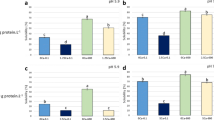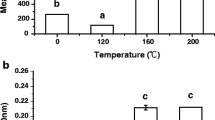Abstract
Soybean protein isolates (SPI) represent an important source of proteins that are used to prepare oil-in-water (o/w) emulsions. The influence of an innovative treatment (high hydrostatic pressure, HHP) combined with calcium addition at different pH levels and protein concentrations on the formation and stability of o/w SPI emulsions was evaluated in this work. When applied separately, calcium addition or HHP treatment produced different effect at pHs 5.9 and 7.0. Calcium addition led to stable emulsions with decreased flocculation index (FI) at pH 5.9 and low protein concentration (5 g L−1), whereas at pH 7.0, this effect was observed at high protein concentration (10 g L−1). In these conditions, calcium would favor the arrival of big aggregates to interface, which would be modified and adsorbed during homogenization. Treatment with HHP decreased FI and stabilized emulsions during storage at pH 7.0 (but not at pH 5.9) when prepared from 10 g L−1 protein dispersions. In these conditions, protein unfolding due to HHP-induced denaturation, and high ζ-potential would be responsible for emulsion improvement. Combination of calcium addition and HHP treatment impaired both formation and stabilization abilities of SPI at both pHs. Bridging flocculation was enhanced in these samples while interfacial protein concentration and percentage of adsorbed protein were increased. Thus, soybean proteins that were subjected to combined calcium addition and HHP treatment exhibited a great ability to associate each other, what can be useful to improve other functional properties such as gelation.







Similar content being viewed by others
References
Agboola, S. O., & Dalgleish, D. G. (1995). Calcium-induced destabilization of oil-in-water emulsions stabilized by caseinate or by β-lactoglobulin. Journal of Food Science, 60(2), 399–404.
Añón, M. C., de Lamballerie, M., & Speroni, F. (2012). Effect of high pressure on solubility and aggregability of calcium-added soybean proteins. Innovative Food Science and Emerging Technologies, 16, 155–162.
Bouaouina, H., Desrumaux, A., Liosel, C., & Legrand, J. (2006). Functional properties of whey proteins as affected by dynamic high-pressure treatment. International Dairy Journal, 16(4), 275–284.
Castellani, O., David-Briand, E., Guérin-Dubiard, C., & Anton, M. (2005). Effect of aggregation and sodium salt on emulsifying properties of egg yolk phosvitin. Food Hydrocolloids, 19(4), 769–776.
Castellani, O., Al-Assaf, S., Axelos, M., Phillips, G. O., & Anton, M. (2009). Hydrocolloids with emulsifying capacity. Part 2- adsorption properties at the n-hexadecane – water interface. Food Hydrocolloids, 24, 161–174.
Chapleau, N., & de Lamballerie-Anton, M. (2003). Improvement of emulsifying properties of lupin proteins by high pressure induced aggregation. Food Hydrocolloids, 17(3), 273–280.
Cui, Z., Chen, Y., Kong, X., & Hua, Y. (2014). Emulsifying properties and oil/water (o/w) interface adsorption behavior of heat soy proteins: effects of heating, concentration, homogenizer rotating speed, and salt addition level. Journal of Agricultural and Food Chemistry, 62, 1634–1642.
Delbyshire, E., Wright, D. J., & Boulter, D. (1976). Legumin and vicilin storage protein of legume seeds. Phytochemistry, 15(1), 3–24.
Dickinson, E. (2010). Flocculation of protein-stabilized oil-in-water emulsions. Colloids Surf B Biointerfaces, 81, 130–140.
Dickinson, E., & Davies, E. (1999). Influence of ionic calcium on stability of sodium caseinate emulsions. Colloids and Surfaces B: Biointerfaces, 12(3–6), 203–212.
Dickinson, E., & Semenova, M. G. (1992). Emulsifying behaviour of protein in the presence of polysaccharide under conditions of thermodynamic incompatibility. Journal of the Chemical Society, Faraday Transactions, 88(6), 849–854.
Floury, J., Desrumaux, A., & Legrand, J. (2002). Effect of ultra-high-pressure homogenization on structure and on rheological properties of soy protein-stabilized emulsions. Journal of Food Science, 67(9), 3388–3395.
Galán, M. G., & Drago, S. R. (2014). Effects of soy protein and calcium levels on mineral bioaccessibility and protein digestibility from enteral formulas. Plants Foods for Human Nutrition, 69(3), 283–289.
Graham, D. E., & Phillips, M. C. (1979). Proteins at liquid interfaces: I. Kinetics of adsorption and surface denaturation. Journal of Colloids and Interface Science, 70, 403–414.
Jones, O. G. (2016). Recent advances in the functionality of non-animal-sourced proteins contributing to their use in meat analogues. Current Opinion in Food Science, 7, 7–13.
Keowmaneechai, E., & McClements, D. J. (2002). Influence of EDTA and citrate on physicochemical properties of whey protein-stabilized oil-in-water emulsions containing CaCl2. Journal of Agricultural and Food Chemistry, 50(24), 7145–7153.
Li, H., Zhu, K., Zhou, H., & Peng, W. (2011). Effects of high hydrostatic pressure on some functional and nutritional properties of soy protein isolate for infant formula. Journal of Agricultural and Food Chemistry, 59(22), 12028–12036.
Manassero, C. A., Vaudagna, S. R., Añón, M. C., & Speroni, F. (2015). High hydrostatic pressure improves protein solubility and dispersion stability of mineral-added soybean protein isolate. Food Hydrocolloids, 43, 629–635.
Manassero, C. A., David-Briand, E., Vaudagna, S. R., Anton, M., & Speroni, F. (2018). Calcium addition, pH and high hydrostatic pressure effects on soybean protein isolates – Part 1: colloidal stability improvement. Food and Bioprocess Technology. Article in press, 11(6), 1125–1138. https://doi.org/10.1007/s11947-018-2084-7.
Markwell, M. A., Haas, S. M., Bieber, L. L., & Tolbert, N. E. (1978). A modification of the Lowry procedure to simplify protein determination in membrane and lipoprotein samples. Analytical Biochemistry, 87(1), 206–210.
Márquez, A. L., Medrano, A., Panizzolo, L. A., & Wagner, J. R. (2010). Effect of calcium salts and surfactant concentration on the stability of water-in-oil (w/o) emulsions prepared with polyglycerol polyricinoleate. Journal of Colloid and Interface Science, 341(1), 101–108.
McClements, D. J. (2005). Food emulsions. Principles, practices, and techniques. Second edition. Boca Raton: CRC Press.
Palou, E., López-Malo, A., Barbosa-Cánovas, G. V. & Welti-Chanes, J. (2000). High hydrostatic pressure and minimal processing. In: S. M. Alzamora, M. S. Tapia, A. López-Malo (Ed.), Minimally Processed Fruits and Vegetables. Fundamentals and applications (pp. 205–222). Gaithersburg: Aspen Publishers.
Patton, S., & Huston, G. H. (1986). A method for isolation of milk fat globules. Lipids, 21(2), 170–174.
Puppo, M. C., Speroni, F., Chapleau, N., de Lamballerie, M., Añón, M. C., & Anton, M. (2005). Effect of high-pressure treatment on emulsifying properties of soybean proteins. Food Hydrocolloids, 19(2), 289–296.
Rodríguez Patino, J. M., Molina Ortiz, S. E., Carrera Sánchez, C., Rodríguez Niño, M. R., & Añón, M. C. (2003a). Behavior of soy globulin films at the air-water interface. Structural and dilatational properties of spread films. Industrial & Engineering Chemistry Research, 42, 5011–5017.
Rodríguez Patino, J. M., Molina Ortiz, S. E., Carrera Sánchez, C., Rodríguez Niño, M. R., & Añón, M. C. (2003b). Dynamic properties of soy globulin adsorbed films at the air-water interface. Journal of Colloid and Interface Science, 268(1), 50–57.
Speroni, F., Jung, S., & de Lamballerie, M. (2010a). Effects of calcium and pressure treatment on thermal gelation of soybean protein. Journal of Food Science, 75, 30–38.
Speroni, F., Milesi, V., & Añón, M. C. (2010b). Interactions between isoflavones and soybeans proteins: Applications in soybean-protein-isolate production. LWT-Food Science and Technology, 43(8), 1265–1270.
Swientek, R. J. (1992). High hydrostatic pressure for food preservation. Food Processing, 53, 90–91.
Tang, C.-H. (2017). Emulsifying properties of soy proteins: a critical review with emphasis on the role of conformational flexibility. Critical Reviews in Food Science and Nutrition, 57(12), 2636–2679.
Utsumi, S., Matsumura, Y. & Mori, T. (1997). Structure-function relationships of soy proteins. In: S. P. A. Damodaran (Ed.), Food Proteins and their applications (pp. 257–291). First edition. New York: Marcel Dekker.
Walstra, P. (1983). Formation of emulsion. In: P.Becher (Ed.), Encyclopedia of Emulsion Technology, Volume 1 Basic Theory (pp. 57–127). New York: Marcel Dekker.
Walstra, P. (1993). Principles of emulsion formation. Chemical Engineering Science, 48(2), 333–349.
Wang, J.-M., Xia, N., Yang, X.-Q., Yin, S.-W., Qi, J.-R., He, X.-T., Yuan, D.-B., & Wang, L.-J. (2012). Adsorption and dilatational rheology of heat-treated soy protein at the oil−water interface: relationship to structural properties. Journal of Agricultural and Food Chemistry, 60(12), 3302–3310.
Wang, C.-Y., Huang, H.-W., Hsu, C.-P., & Yang, B. B. (2016). Recent advances in food processing using high hydrostatic pressure technology. Critical Reviews in Food Science and Nutrition, 56(4), 527–540.
Wang, X., Zeng, M., Qin, F., Adhikari, B., He, Z., & Chen, J. (2018). Enhanced CaSO4-induced gelation properties of soy protein isolate emulsion by pre-aggregation. Food Chemistry, 242, 459–465.
Ye, A., & Singh, H. (2000). Influence of calcium chloride addition on the properties of emulsions stabilized by whey protein concentrate. Food Hydrocolloids, 14(4), 337–346.
Ye, A., & Singh, H. (2001). Interfacial composition and stability of sodium caseinate emulsions as influenced by calcium ions. Food Hydrocolloids, 15(2), 195–207.
Yuan, D. B., Yang, X. Q., Tang, C. H., Zheng, Z. X., Wei-Min, Ahmad, I., & Yin, S. W. (2009). Physicochemical and functional properties of acidic and basic polypeptides of soy glycinin. Food Research International, 42(5–6), 700–706.
Acknowledgements
The authors thank Marie de Lamballerie for facilitating the use of HHP equipment installed in ONIRIS. The stay of Carlos A. Manassero in Biopolymères Interactions Assemblages-INRA was funded by Bec. Ar program of Argentina.
Author information
Authors and Affiliations
Corresponding author
Rights and permissions
About this article
Cite this article
Manassero, C.A., Beaumal, V., Vaudagna, S.R. et al. Calcium Addition, pH and High Hydrostatic Pressure Effects on Soybean Protein Isolates—Part 2: Emulsifying Properties. Food Bioprocess Technol 11, 2079–2093 (2018). https://doi.org/10.1007/s11947-018-2164-8
Received:
Accepted:
Published:
Issue Date:
DOI: https://doi.org/10.1007/s11947-018-2164-8




